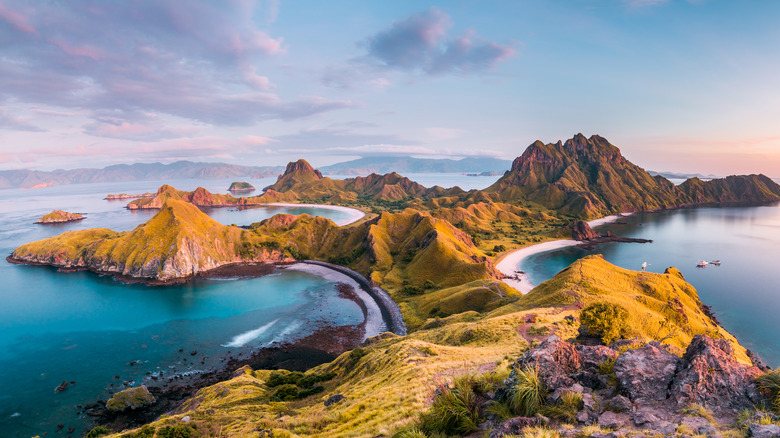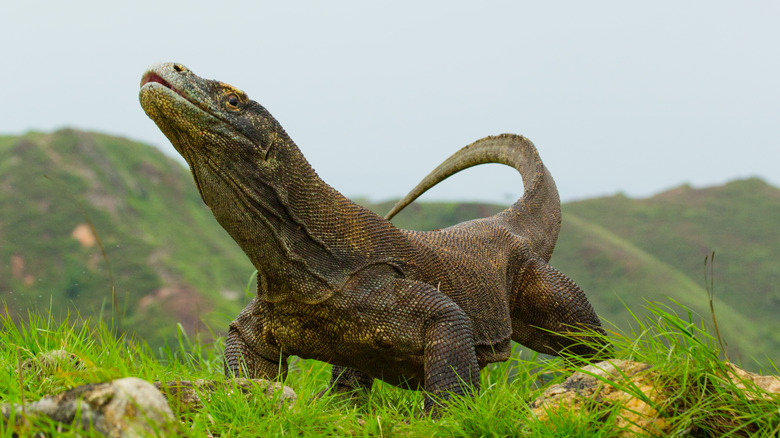The Truth About Indonesia's "Jurassic Park" Project
So you know how 1993's "Jurassic Park" is supposed to be a cautionary tale about the dangers of letting blind human ambition, egotism, and greed guide scientific advancements, but everyone just leaves the theater blurting, "Whoa, dinosaurs are cool!" And how 2015's "Jurassic World" expanded on that central premise, but people just left the theater muttering, "So how did Chris Pratt control those dinosaurs with his hands, again?" Yeah, plenty of folks miss the point. And despite dwelling in a world steeped in sci-fi paranoia about evil AI, evil genetically-modified monsters, evil corporate overlords, and the like, it's amazing to think how far down the dystopian path we've tread.
Enter: Jurassic ... Park! (Cue the John William's theme music.) Except whoa, whoa, dial it back and reign in your expectations. We're not talking a verdant jungle land of interactive rides racing alongside herds of cloned Stegosauri. We're talking Rinca Island in Komodo National Park, part of the Indonesian archipelago and dedicated World UNESCO Heritage site established in 1980, per National Geographic. The 700-square-mile refuge-from-humanity for flora and fauna, particularly one of Earth's last living, actual pseudo-dinosaurs, the Komodo Dragon, has been targeted by the Indonesian government for conversion into a "premium tourism spot," as IFL Science says.
This particular "Jurassic Park" is less of a Spielberg fairyland where kids' dreams go off-script, and more of an act of environmental desecration where dreams of respect for nature turn into nightmares akin to hunting elephants for tusks or sheering clean the Amazonian and Bornean rainforests.
The proposed 'Jurassic Park' is home to the Komodo Dragon
Komodo National Park is one of the only homes on Earth left for the Komodo Dragon, who arrived in the Indonesian archipelago from Australia, where they first appeared about 4 million years ago, as ABC News explains. At various epochs when water levels were lower, the dragons trundled across to Flores, Bornea, and more, which is good, because when humans first arrived in Australia about 50,000 years ago, the Komodos there went extinct. Komodo National Park, by comparison, stayed comparatively human-free.
Komodo Dragons are a hardy species, though, no matter that their remaining numbers have dwindled to a mere 6,000. They measure 10 feet long, weigh over 300 pounds, and live up to 30 years, per National Geographic. They can asexually reproduce in the absence of a male partner through a process called parthenogenesis (but only produce male offspring as a result), and eat practically anything, including the pigs, buffalo, and deer introduced to their habitats via humans. Their bite can crush bones and leave venom besides, meaning that any prey who escapes will likely be bleed out while poisoned, and be tracked by scent along the way. And since Komodo Dragons can eat up to 80% of their body weight in a single meal, even a pesky human interloper wouldn't prove troublesome for digestion.
And yet, there are plenty of villages where Komodos have been habituated to co-exist alongside schoolchildren, kind of like stray dogs in the back yard.
Photos of Komodo Dragons aside construction equipment
In 2019, the Indonesian government closed Komodo National Park to visitors (yes, tourists can go there) because a lizard-smuggling ring was discovered filching endangered species from the island, as the BBC says. They stole 45 Komodos and sold 41. Now, though, the Indonesian government is apparently moving ahead with far more destructive plans to terraform Komodo National Park and build a tourist resort there to complement the nation's other hotspot of glitz and beach-sipped cocktails, Bali.
Twitter account @KawanBaikKomodo and others have done their best to highlight the construction project's desecration of the natural environment, largely consisting of clearcutting and bulldozing to the present. One photo in particular, shared by the activist group Save Komodo Now (per the BBC), cropped up on Instagram in 2020 and ignited rage among conservationists. It shows dudes in hardhats sitting on a construction truck staring down at a Komodo Dragon standing in the furrowed soil of a construction zone. Even officials from UNESCO have been knocking on the Indonesian government's door, as IFL Science says, stating that the project — which consists of still-undisclosed details — "raises the question of how this tourism model fits with the State Party's vision of moving away from mass tourism to more sustainable approaches."
To this, the Director-General of Nature Conservation and Ecosystems at the Indonesian Ministry of Environment responded, offering no additional information, "This project will proceed. It's been proven to have no impact [on the dragons' habitat]."
Dragon vs. Truck at the heart of flip-flopped governmental conservationism
The infamous and wonderfully symbolic Dragon vs. Truck photo perfectly captures the essence of what's happening on Rinca Island in Komodo National Park. Its caption states (as translated), "Komodo faces off against a Jurassic Tourism construction project truck on Rinca Island. For the first time, these Komodo Dragons heard the roar of car engines and inhaled the smoke. What will be the impact of these projects in the future? Does anyone still care about conservation?" In fact, the project has no official governmental name yet, as the BBC states. "Jurassic Park" is a derogatory term that's been conjured by critics to draw attention to the precise problems highlighted in 1993's "Jurassic Park": blind ambition, manipulation of the environment, toying with nature, and so on.
Komodo National Park is composed of several islands: Komodo, Rinca, Padar, Nusa Kode, and Gili Motang, each with a separate Komodo population. Rinca Island, Jurassic Park's prospective location, contains the second-highest population of Komodo Dragons. About 2,000 indigenous inhabitants live on these islands side-by-side with the Komodo Dragons, per the BBC. Greg Afioma, a member of Save Komodo Now, stated, "This kind of massive development disturbs the interaction of the animals. It will change their habitat."
It's suspected that the reduction in tourism due to COVID-19 is responsible for what was previously an overtly conservationist stance from the Indonesian government.



